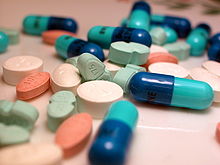
Back Geneesmiddel Afrikaans Arzneimittel ALS Medecina AN دواء Arabic ঔষধ Assamese Melecina AST Dərman Azerbaijani درمان AZB Дауа саралары Bashkir Liekarsta BAT-SMG
| Medication | |
|---|---|
 Packages of medication (tilidin) | |
| Other names | Medicine, drug, pharmaceutical, pharmaceutical preparation, pharmaceutical product, medicinal product, medicament, remedy |

A medication (also called medicament, medicine, pharmaceutical drug, medicinal drug or simply drug) is a drug used to diagnose, cure, treat, or prevent disease.[1][2] Drug therapy (pharmacotherapy) is an important part of the medical field and relies on the science of pharmacology for continual advancement and on pharmacy for appropriate management.
Drugs are classified in many ways. One of the key divisions is by level of control, which distinguishes prescription drugs (those that a pharmacist dispenses only on the order of a physician, physician assistant, or qualified nurse) from over-the-counter drugs (those that consumers can order for themselves). Another key distinction is between traditional small molecule drugs, usually derived from chemical synthesis, and biopharmaceuticals, which include recombinant proteins, vaccines, blood products used therapeutically (such as IVIG), gene therapy, monoclonal antibodies and cell therapy (for instance, stem cell therapies). Other ways to classify medicines are by mode of action, route of administration, biological system affected, or therapeutic effects. An elaborate and widely used classification system is the Anatomical Therapeutic Chemical Classification System. The World Health Organization keeps a list of essential medicines.
Drug discovery and drug development are complex and expensive endeavors undertaken by pharmaceutical companies, academic scientists, and governments. As a result of this complex path from discovery to commercialization, partnering has become a standard practice for advancing drug candidates through development pipelines. Governments generally regulate what drugs can be marketed, how drugs are marketed, and in some jurisdictions, drug pricing. Controversies have arisen over drug pricing and disposal of used Medicine .
- ^ "Federal Food, Drug, and Cosmetic Act, SEC. 210". U.S. Food and Drug Administration. (g), (1), (B). Archived from the original on 12 May 2009. Retrieved 17 August 2008.
- ^ "Directive 2004/27/EC of the European Parliament and of the Council of 31 March 2004 amending Directive 2001/83/EC on the Community code relating to medicinal products for human use – Article 1". Published 31 March 2004. Accessed 17 August 2008. Archived 30 April 2021 at the Wayback Machine.